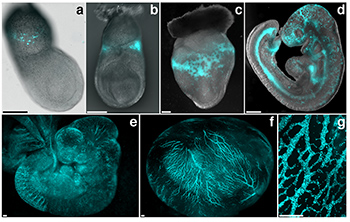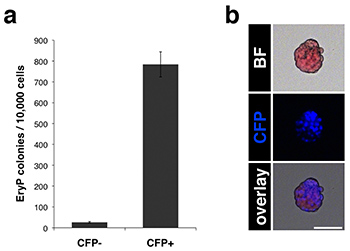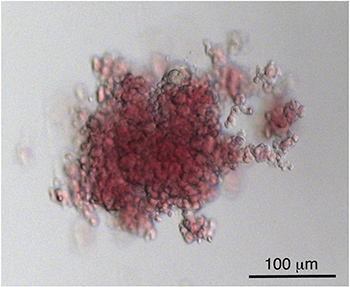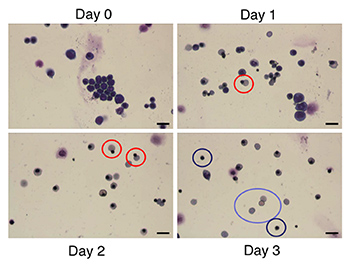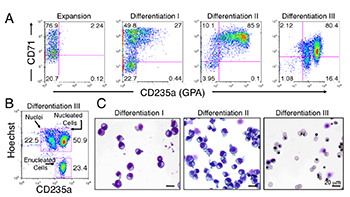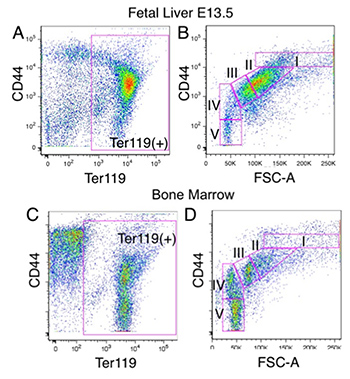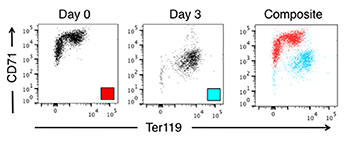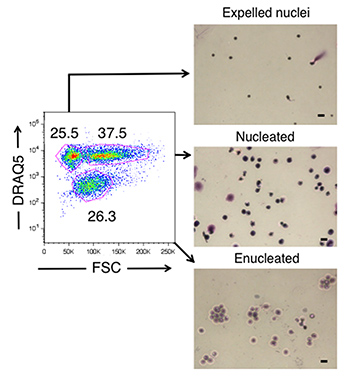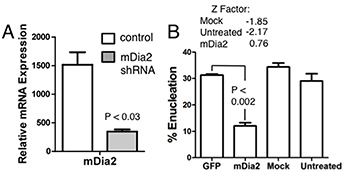Regulation of erythroid development by the canonical Wnt/β-catenin signaling pathway
Approaches
- transgenic mice carrying fluorescent reporters for primitive (embryonic) erythropoiesis
- transgenic reporter line for Wnt pathway activity (Fig. 2)
- knockout mice, Cre-inducible mice (conditional activation)
- multicolor flow cytometry (sorting and analytical)
- clonogenic colony assays for embryonic (Fig. 3) and adult erythroid (Fig. 4)progenitors
- RNAseq analysis of cell populations sorted on the basis of level of Wnt pathway activity
- high throughput screening for regulators of erythroid development
- mouse and human ES cell differentiation
Translation to clinical practice : An understanding of red blood cell development at various stages of red cell ontogeny and comparisons between the primitive and definitive systems will be invaluable for the development of efficient methods for the production of transfusable red blood cells. The canonical Wnt/β-catenin signaling pathway is co-opted during regeneration of the adult hematopoietic system following injury and is subverted in certain leukemias. Therefore, these studies may provide insights into the hematopoietic response to stresses such as irradiation and anemias of various etiologies.
Figure 1. CFP expression during the development of ε-globin-H2B-CFP embryos. The histone H2B-CFP reporter is driven by human embryonic globin regulatory elements and is expressed in primitive (embryonic) erythroid cells. (a-d) Overlay of bright field and CFP channel fluorescence for an E7.0 (a), E7.5 (b), E8.5 (c) and E9.5 (d) ε-globin-H2B-CFP transgenic embryo. (e-g) CFP fluorescent images of an E10.5 embryo (e), an E10.5 embryo in the yolk sac (f), and a detail of a E10.5 yolk sac (g). Scale bars, 200 µm. From Vacaru et al. (2013) Genesis 51(11): 751-762.
Figure 2. Expression of a TCF/Lef-H2B-GFP transgenic reporter for the canonical Wnt signaling pathway. (A) Anterior view of ~E7.75 TCF/Lef-H2B-GFP embryo; nuclei stained with Hoechst. 3D reconstruction of a z-stack acquired using a Zeiss LSM 510 microscope. White box indicates the blood islands of the YS. Scale bar, 100 µm. (B) High magnification view of boxed region in (A). Scale bar, 50 µm. From Isern et al. (2011) Blood 117:4924-4934. (C) Expression of TCF/Lef-H2B-GFP reporter in EryP. E7.75 embryos doubly transgenic for TCF/Lef-H2B-GFP and ε-globin-H2B-CFP (Fig. 1) were analyzed using confocal microscopy. “Merge” panel shows EryP in which the Wnt pathway is active. (D) Proximal (P, near implantation site) to distal (D) gradient of Wnt activity in yolk sac EryP. Confocal images of ~E7.75 embryo and overlay of fluorescence images (boxed region enlarged at right).
Figure 3. Primitive erythroid (EryP) progenitor activity in ε-globin-H2B-CFP embryos. (a) Representative EryP progenitor assay of CFP-postive and -negative cells sorted from E8.5 ε-globin-H2B-CFP embryos (mean of 3 technical replicates ± SD). (b) Bright field and fluorescent images of an EryP colony. Images were acquired using a Zeiss AxioCam color camera mounted on a Zeiss Axio Observer Z1 inverted microscope and outfitted with a EC Plan-Neofluar 10x/0.30 objective. Scale bar, 50 µm. From Vacaru et al. (2013) Genesis 51(11): 751-762.
Figure 4. BFU-E erythroid colonies from mouse fetal liver. Definitive (adult type) erythroid progenitors are found in the fetal liver and adult bone marrow. BFU-E are an earyly progenitor cell that forms large, diffuse colonies with a characteristic morphology, shown in this image (E12.5 fetal liver).
Regulation of definitive erythroid development by ligand-activated transcription factors
Approaches
- In vitro culture systems for maturation of mouse (Fig. 5) and human (Fig. 6)erythroid progenitors
- Flow cytometric analysis of erythroid cell maturation (Figs. 7, 8, 9, 10)
- RNAseq analysis of FACS-sorted erythroid progenitors
- Lentiviral shRNA mediated gene knockdown analysis (Fig. 11)
Translation to clinical practice: Anemia is a global health problem that causes significant morbidity and mortality. A mainstay of many medical therapies for anemia is red blood cell (RBC) transfusion but blood supplies are limited. An understanding of how the growth of erythroid progenitors and the switch from self-renewal to differentiation are controlled might facilitate the development of novel erythropoiesis stimulating agents (ESAs) with fewer side effects than erythropoietin (EPO, a hormone used to treat many types of anemia) and might lead to improved, more efficient systems for the generation ex vivo of RBCs (or their progenitors) for transfusion.
Figure 5. Culture of mouse fetal liver erythroid progenitors. Ter119-depleted (Miltenyi autoMACS-separated) E12.5 FL cells were expanded for 3d and then induced to mature. Cells were cytospun and stained with May-Grunwald Giemsa. Red circles, enucleating erythroblasts; purple, extruded nuclei; lavender, reticulocytes. Frequency of enucleation (# enucleated cells / total nucleated + enucleated) is typically 55-70%. Scale, 20 microns.
Figure 6. Culture system for erythroid differentiation from human CD34(+) progenitors. Human CD34(+) cells from PB (purchased from FHCRC) were induced to differentiate using a multi-step scheme. (A) Analysis of erythroid maturation based on expression of CD71 and CD235a (Glycophorin A). The cells are initially CD71(+) CD235a-neg, begin to express CD235a and lose expression of CD71. (B) Analysis of enucleation based on staining of DNA with Hoechst and expression of CD235a. Enucleated cells are observed by the end of Differentiation III. (C) Cells were cytospun and Giemsa stained. During culture, the cells decrease in size, exhibit nuclear condensation, and enucleate. Scale bars, 20 microns.
Figure 7. Flow cytometric analysis of E13.5 mouse fetal liver (FL, A, B) and bone marrow (BM, C, D) erythroid cells labeled with antibodies against Ter119 and CD44. Ter119(+) cells were separated into populations based on FSC-A and CD44, where progenitors are found within gate I and maturing cells are in gates II (largely basophilic erythroblasts) – V (largely erythrocytes). Method as in Chen et al. (2009) Proc Natl Acad Sci U S A. 106: 17413-17418.
Figure 8. Flow cytometric analysis of CD71 and Ter119 in E14.5 mouse FL erythroblasts cultured as in Fig. 5. Analysis as in Zhang et al. (2003) Blood 102: 3938-3946. As the cells mature, they shift from CD71(+) Ter119neg/low basophilic erythroblasts and small numbers of progenitors to CD71negTer119(+) enucleated cells.
Figure 9. Flow cytometric analysis of cultured FL erythroblasts. (A) Analysis of CD71 and FSC in E14.5 FL erythroblasts cultured as in Fig. 3 Flow cytometric analysis as in Zhang et al. (2003) Blood 102: 3938-3946. (B) Analysis of DRAQ5 staining and FSC. Note the large increase in enucleated cells on day 3 (54%) compared with the starting population at day 0 (7.4%). (A) and (B) are from different experiments.
Figure 10. Flow cytometric analysis of nucleated erythroblasts, enucleated cells and extruded nuclei from mouse FL cell cultures. E12.5 FL cells were isolated and cultured for 3d as in Fig. 5, then FACS sorted on the basis of DRAQ5 nuclear staining and FSC, and finally cytospun and stained with May-Grunwald Giemsa.
Figure 11. An example of an shRNA lentivirus knockdown in Linneg fetal liver (FL) cells. Knockdown of mDia2 results in a statistically significant reduction in enucleation compared to controls, in agreement with a published study (Ji et al. (2008) Nat Cell Biol. 10(3):314-321). Linneg E12.5 FL cells were cultured in triplicate with shRNA or control lentivirus for 2d under maturation conditions. Puromycin (1 µg/ml) was added for an additional 2d. Cells were harvested for analysis of RNA expression (A) and erythroid maturation, in this case by calculating % enucleation (B) on the basis of DRAQ5 staining and FSC. In B, data were analyzed for statistical significance by calculating Z factors; GFP served as the control in this calculation. The Z factor of 0.76 for mDia2 represents an excellent, screenable assay (0.5 ≥ Z < 1.0). Error bars, S.D. (N = 3). P values calculated using two-tailed Student’s t-test.
Margaret Baron Laboratory
Lab:
Annenberg 24-68
212-241-0838
Admin Phone: 212-241-6287
Fax: 646-537-8698
Email: margaret.baron@mssm.edu
Office:
Annenberg 24-04E
212-241-0825
Icahn School of Medicine at Mount Sinai
1468 Madison Avenue, AB24-68
Box 1079
New York, NY 10029

